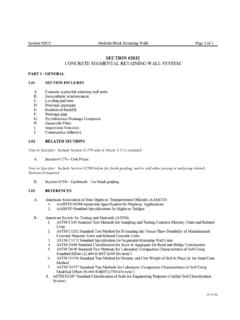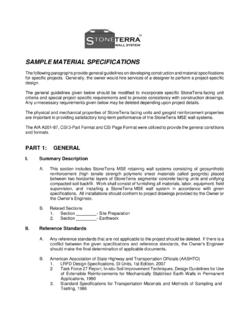Transcription of Guideline for the Geotechnical Design of Underground ...
1 Austrian Society for Geomechanics Guideline for the Geotechnical Design of Underground Structures with conventional Excavation Ground characterization and coherent procedure for the determination of excavation and support during Design and construction Translated from version 2010 Publisher: Austrian Society for Geomechanics A-5020 Salzburg, Bayerhamerstrasse 14 Tel.: +43 (0)662 875519, Fax: +43 (0)662 886748 E-mail: Copyright GG Salzburg, 2010 Guideline for the Geotechnical Design of Underground Structures with conventional Excavation Austrian Society for Geomechanics I Table of Contents 1 Introduction .. 1 2 Targets .. 3 3 Definitions .. 5 4 Phase 1 - Design .. 7 Basic 7 Determination of Ground Types .. 10 Method .. 10 Records .. 13 Determination of Ground 13 Method .. 13 Records .. 16 Selection of construction concept and evaluation of System Behaviour in the excavation 16 Detailed determination of construction measures and evaluation of system behaviour in supported area.
2 17 Influencing factors .. 17 Method .. 17 Analyses and Proofs .. 17 Records .. 18 Determination of tunnelling classes .. 18 Geotechnical 18 Contents .. 18 Contents of the Framework 19 5 Phase 2 - Construction .. 20 Basic procedure .. 20 Determination of actual ground type .. 23 Preparation and 23 Collection of parameters on site and determination of ground type .. 23 Assessment of system behaviour in the excavation area .. 23 Method .. 23 Determination of excavation and support and prediction of System 24 Comparison with the Framework 24 Decisions on site .. 24 Guideline for the Geotechnical Design of Underground Structures with conventional Excavation II Austrian Society for Geomechanics Refinement of correlation criteria ..24 Refinement of the prediction of the System Check of System Behaviour ..25 Updating of 6 References ..27 Appendix Soil, rock and ground parameters Guideline for the Geotechnical Design of Underground Structures with conventional Excavation Austrian Society for Geomechanics 1 1 INTRODUCTION One goal of the Austrian Society of Geomechanics is to improve the communica-tion between clients, geologists, engineers, and contractors in the field of geotech-nical engineering, as well as the improvement of Design and Design procedures for projects involving rock and soil.
3 The Guideline has first been established in conjunction with the new edition of the Austrian Standard ONORM B2203-1 [1] in 2001. This standard deals with contrac-tual matters for Underground construction with conventional excavation. All sub-jects related to ground characterization and behaviour evaluation have been sum-marized in the Guideline published by the OGG, which the Standard ONORM B2203-1 refers to. The Guideline cannot be used as a basis for contractual mat-ters. The Guideline was revised in 2008 and replaces the edition from 2001. The stability of Underground structures is a key issue during Design and construc-tion. Depending on the Geotechnical conditions and influencing factors, different failure modes can be expected. Depending on the potential failure modes, project specific requirements and boundary conditions, specific construction measures to ensure stability have to be chosen. Due to the variation in the Geotechnical conditions (the static system and the ca-pacity of ground and supports) the Design of an Underground structure cannot be compared to a structural Design of other buildings, where the loads, the system, and the characteristics of the materials used are known.
4 In Underground construction the risks associated with construction cannot be pre-cisely defined due to the uncertainties of the Geotechnical model. This circum-stance requires a continuous adaptation of the construction method to the actual ground conditions, and the implementation of a safety management system [2, 3]. The safety management system has to cover following topics: A Design concept for the determination of excavation and support Criteria for the assessment of the stability based on the knowledge of the ground conditions during Design A monitoring concept with all technical and organizational provisions to allow a continuous comparison between the expected and actual conditions A management concept for cases where the actual conditions deviate from the expected range, both in unfavourable and favourable direction In Underground engineering there are two major aspects that must be addressed during the Design phase.
5 The first and most important is developing a realistic es-timate of the expected ground conditions and their potential behaviours as a result of the excavation. The second is to Design an economic and safe excavation and support method for the determined ground behaviours. The Design process begins with the feasibility study and continues through the preliminary Design , the detail Design , the tender Design , and throughout the construction. The Design is con-stantly updated during each stage, as more information is available. This requires the involvement of geological and Geotechnical experts in all phases of a project. A central issue for all Geotechnical designs is the ground- structure interaction. This not only includes the final state, but also the transient effects of the construction processes, as well as time and stress dependent ground properties. During the Design phases the inherent complexity and variability in many geologi-cal settings prohibits a complete picture of the ground structure and quality to be Guideline for the Geotechnical Design of Underground Structures with conventional Excavation 2 Austrian Society for Geomechanics excavated.
6 The Geotechnical Design is targeted to a continuous refinement of the models and decision criteria. Besides a high professional standard, a systematic and consistent, well documented evaluation and decision process is of paramount importance. Uncertainties in the ground model shall be considered in the Design . Depending on the ground properties and the boundary conditions of a project, the importance of the geomechanical Design and the structural Design will vary. Most countries have regulations regarding the structural Design of Underground struc-tures, especially in urban areas. The Austrian Guideline RVS may serve as an example. The Guideline contains a description of the general procedure to be followed for the Geotechnical Design . It addresses everybody involved in an Underground pro-ject, and assists in efficiently preparing and organizing the Geotechnical Design during all phases of a project.
7 The Guideline does not contain distinct stipulations for engineering tasks. Contractual matters, like sharing of geological risk, matters of responsibility or site organization are not addressed in this technical Guideline , as the conditions will vary from project to project. Guideline for the Geotechnical Design of Underground Structures with conventional Excavation Austrian Society for Geomechanics 3 2 TARGETS The main task of the Geotechnical Design is the economic optimization of the con-struction considering the ground conditions as well as safety, long term stability, and environmental requirements. The variability of the geological architecture including the local ground structure , ground parameters, stress and ground water conditions requires that a consistent and specific procedure be used during the Design process. The key influences governing the Geotechnical Design are the ground conditions and ground behav-iour.
8 Existing schematic rating systems and their recommendations for excavation and support have been developed from experience under specific conditions. A gener-alization for other ground and boundary conditions frequently leads to inadequate Design [4]. Consequently a technically sound and economical Design and construc-tion can be achieved only by applying a project and ground specific procedure. In spite of all uncertainties in the description of the ground conditions, Underground engineering needs a strategy, allowing a consistent and coherent Design procedure that is traceable throughout the entire project, and an optimal adjustment of the construction to the actual ground conditions encountered on site. Two main phases can be distinguished: Phase 1: Design This phase involves determining the expected ground properties, the classification into Ground Types (GT), the assessment of the Ground Behaviours, its categoriza-tion into Ground Behaviour Types (BT), as well as the determination of construction measures derived from the ground behaviour under consideration of the project specific boundary conditions.
9 On this basis the expected System Behaviour is pre-dicted. Tunnelling classes are then determined according to the rules stipulated in ONORM B2203-1. The results of all phases of the Geotechnical Design are summarized in a geotech-nical report. The Geotechnical report clearly has to show, on which ground condi-tions, boundary conditions, and other assumptions the Design is based. The frame-work plan is part of the Geotechnical report. This plan has to contain clear applica-tion criteria, and shall indicate which measures shall not be modified during con-struction without consent of the designer, as well as the criteria for possible modifi-cations and adjustments during construction. Phase 2: Construction During construction Geotechnical relevant ground parameters have to be collected, recorded, and evaluated to determine the ground type. Under consideration of the influencing factors the actual System Behaviour in the excavation area is assessed according to the stipulations of the Design .
10 Excavation and support measures have to be chosen based on the criteria laid out in the framework plan and the safety management plan. The Geotechnical Design and the framework plan have to be continuously updated based on the findings on site. The improved quality of the Geotechnical model al- Guideline for the Geotechnical Design of Underground Structures with conventional Excavation 4 Austrian Society for Geomechanics lows an optimization of the construction while observing all safety and environ-mental requirements. The relevant data and assumptions made for all decisions during Design and con-struction have to be recorded. Relevant information in connection with the ground properties, ground and system behaviour has to be collected, evaluated and ana-lyzed in both phases. The Guideline shall help to follow a systematic procedure. All concepts, considera-tions and decisions shall be recorded in a way, that a review of the decision making process is possible.





